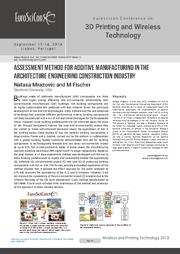LiFi for 5G and beyond wireless communications networks
Hoa Le Minh
2018
American Journal of Computer Science and Information Technology
E u r o s c i c o n C o n f e r e n c e o n 3D Printing and Wireless Technology S e p t e m b e r 1 7 -1 8 , 2 0 1 8 L i s b o n , P o r t u g a l Wireless and Printing Technology 2018 B uildings made of additively manufactured (AM) components are likely to have higher energy efficiency and environmental sustainability than conventionally manufactured (CM) buildings. AM building components can be highly customizable and produced with less material. Given the continued development of AM and CM
more »
... chnologies, many markets and the use scenarios of buildings that prioritize different performance criteria, building components will likely be produced with a mix of AM and CM technologies for the foreseeable future. However, since building professionals are not informed about the value of AM through transparent metrics like cost and environmental impact they are unable to make well-informed decisions about the application of AM in the building sector. Case studies of two AM metallic building components, a large window frame and a bracket, carried out by the authors in collaboration with a global building façade contractor demonstrated that AM for building components is technologically feasible and can lower environmental impact by up to 87%, but is cost-prohibitive today; in some cases, the manufacturing cost and schedule were about 90% higher and 91% longer respectively. Based on the case studies, a 19 step assessment method was developed with the aim to allow building professionals to rapidly and consistently assess the applicability (A), schedule (S), environmental impact (E), and cost (C) of producing building components with AM vs. CM. The formal, partially automated application of the method showed that it reduces the effort required for the ASEC analyses by 97% and improves the consistency of the A, S, and C analyses. However, it did not improve the consistency of the environmental impact (E) analysis due to the inherent flexibility of the life cycle assessment (LCA) method standardized by ISO14040. Future work includes fuller automation of the method and extension of this approach to other industry sectors. Figure 1: Observed problem: building professionals are unable to make well-informed decisions about the application of AM in their projects, because they are not informed about the value of AM through transparent metrics like cost and environmental impac Figure 2: High-level concept diagram of the workflow of the assessment method.
doi:10.21767/2349-3917-c2-005
fatcat:sa4vsv6xdjcoxlrtq6f2jrot6m

